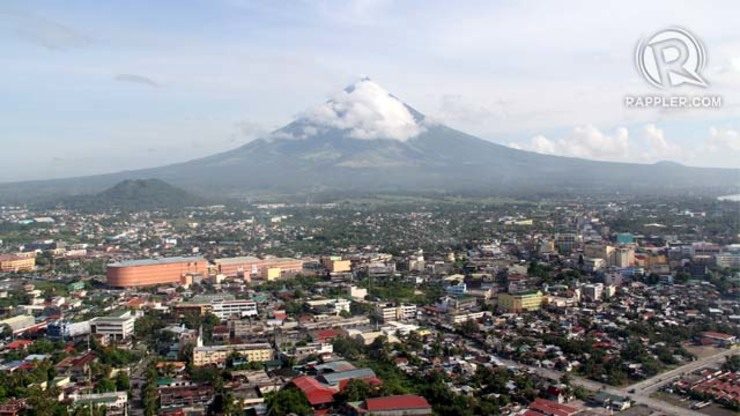SUMMARY
This is AI generated summarization, which may have errors. For context, always refer to the full article.

ALBAY, Philippines – The provincial government of Albay estimates that it will need at least P117.7 million ($2.6 million)* every month to tide over its thousands of evacuees until they can go home.
This is based on the total amount they have spent as of Thursday to provide food, temporary shelter, and other basic services to their more than 50,000 evacuees, said Office of Civil Defense Region 5 Director Raffy Alejandro during a press conference on Friday, October 3, the 19th day since alert level 3 was hoisted over Mayon Volcano.
“These funds went to buying supplies for evacuees which are good for one month. So, more or less, this is what we’ll need each month,” he told Rappler.
Expenses made in preparation for the imminent Mayon eruption has so far amounted to P117,692,004.20.
This is a combination of Albay local government funds (P63.39 million) and national government funds (P54.3 million).
This assistance came in the form of food items, medicine, hygiene kits, and health insurance, said Alejandro.
Aside from this assistance, international aid agencies like the United Nations, USAID, and World Food Program have also donated tents, tarpaulins, rice, and other materials, said Albay Governor Joey Salceda.
The national government has also committed to provide an additional P93.8 million worth of assistance.
P1.4 million worth of food preparation kits, like portable cooking stoves and water purifying machines, will also be turned over on October 3.
As of October 2, there were 50,222 persons or 12,480 families in evacuation centers in various parts of the province.
To avoid spread of sickness – something that has become more common because of recent rains and cold weather – the local government is limiting the number of people per room or tent to 30, following international standards for evacuation, said Salceda.
One health concern they have yet to address fully is the lack of bathrooms, hence some evacuees tend to return to their homes just to take a bath.
“By next week, hopefully we will reach a certain level in which we are comfortable and the evacuees don’t have a reason to go home,” said Salceda.
Watch Salceda’s press conference below.
Mayon activity
In the past 24 hours, 7 rockfalls were detected in the volcano, Mayon volcanologist Ed Laguerta said during the press conference.
Watch his press conference below.
The latest data gathered by the Philippine Institute of Volcanology and Seismology (Phivolcs) shows increasing inflammation or rising of magma in the lower part of the volcano.
“The lower portion is definitely inflated but it hasn’t reached the upper portion yet. The trend is an increasing trend. We are monitoring if it will accelerate,” the volcanologist said.
Phivolcs scientists are expecting the magma to rise significantly in the next few weeks. They also detected increasing pressurization, which also points to an eruption.
Gases released by new magma reaching higher chambers of the volcano may lead to a soda bottle effect, in which increased air pressure in the volcano triggers an explosive eruption.
Some sure signs of an imminent explosive eruption are ground shaking, tremors (continuous ground vibration), and fracturing of the ground, he added.
Based on Mayon’s past behavior, the first eruption will likely be a Strombolian eruption – a low-level eruption during which incandescent rocks or lava bombs are ejected tens to thousands of meters into the air.
They are mildly explosive at fairly regular intervals and are not as loud as more explosive eruptions.
It will likely be followed by a vulcanian eruption, a stronger eruption, causing the ejection of heavier rocks.
The explosion of gases during a vulcanian eruption may be fast enough to cause shockwaves. It may also cause volcanic ash and rocks to sweep over a wider area than during a Strombolian eruption.
It’s only after the vulcanian eruption that authorities can begin counting the days until they can send evacuees home, said Salceda.
Waiting
Every day brings Albay closer to Mayon’s eruption. Based on previous eruptions, Mayon will be under alert level 3 for around 75 days more before erupting. Hence, the Albay provincial government is preparing to maintain evacuation centers for just as long.
The figure was arrived at by averaging the number of days Mayon spent under alert level 3 in previous years.
But there is a possibility that the waiting will go beyond the 75 days, said Salceda.
One thing is for sure, agreed Salceda and Laguerta: once Mayon gets started, it will continue to its inevitable conclusion – a hazardous eruption.
“Once alert 4 is there, only 10 hours after, it’s already alert 5, which is state of eruption. There’s no way for this volcano except to erupt. It’s only a question of time.” – Rappler.com
*US$1 = P45.27
Add a comment
How does this make you feel?
There are no comments yet. Add your comment to start the conversation.